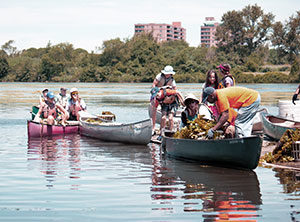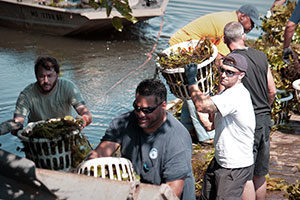
— Photos by Lita Vongsavanh
By Sanjeev Selvarajah
This season’s spikes of heat and cool haven’t stopped a whopping thousand people from combing the Mystic River for the invasive water chestnut that hinders activities and harms animal habitats. Businesses and community volunteers went out on canoes to hand pull the invasive plant and clear the Mystic River of the infestation. The zeal and methodology with which Mystic River’s neighboring towns operate to clean up the invasive water chestnut from the waterway should be applauded and used in the cases of water contamination nationwide.
There are over 44 lakes and ponds that fill the Mystic River. Twenty-two communities occupy the area of the watershed encumbered because of the water chestnut, brought to America by a gardener in the late 1800s. Two intrepid co-workers from Mystic River Watershed Association, Beth MacBlane and Andy Hrycyna worked hard to inspire the groups of eager employees who would love to get away from their cubicles for a summer day well spent, and eco-conscious public folk who wanted to paint the town green.
“Saturday’s event was a terrific success. We partnered with Athena Health, Office of Congresswoman Clark, Xcenda, BNY Mellon and Groundwork Somerville. The groups worked together to remove more than 5,000 pounds of water chestnuts from the Mystic River,” says MacBlane.
 “I’ve always been passionate about environmental issues and attribute that to positive childhood experiences spent outside. I view the Mystic as a terrific natural resource for many, many people, and the challenge is to get them to the river. I enjoy working with the public and engaging people in the life of the river. I think there is great potential for the Mystic and for the Mystic River Watershed Association,” MacBlane said.
“I’ve always been passionate about environmental issues and attribute that to positive childhood experiences spent outside. I view the Mystic as a terrific natural resource for many, many people, and the challenge is to get them to the river. I enjoy working with the public and engaging people in the life of the river. I think there is great potential for the Mystic and for the Mystic River Watershed Association,” MacBlane said.
The Amelia Earhart Dam in Somerville is just one of many endangered landmarks that MyRWA works to save by corralling funding and volunteers to help with the insufferable weed. In past years MyRWA’s Patrick Herron was awarded the Environmental Merit Award from the Environmental Protection Agency.
Andy Hrycyna, the Watershed scientist who oversaw Saturday’s public event said, “We got great help in running yesterday’s community event by crews from the Massachusetts Department of Conservation and Recreation (DCR) and the Massachusetts Water Resources Authority (MWRA).”
“The amount of life bordering and living in the river is startling. Urban rivers still have abundant life in them. They still provide essential habitat. Based on a program we gave to count fish this year, we estimate that at least half a million river herring migrated up from Boston Harbor to the Mystic lakes to spawn, an amazing urban migration that not many people know about,” said Hrycyna.
“I would urge young people to realize that they can make a difference in protecting the natural world, even as we continue to affect it through everything we do. Our shared future depends on sustainably managing our relationship with natural systems. There are so many ways to help make this happen. It starts with knowing what’s there, and I’d urge young people to get outside. Experience your urban river. Get out on the water, or walk in a riverfront park. And think about the way this water is connected to so many other things from the life of birds to the health of coastal habitats. And get involved in some way. Positive change depends on you.”
“People are drawn to rivers and the parks that border them for many different reasons. They are wonderful places for people in densely populated areas of cities to experience nature, and to experience the benefits of being outside, of being in contact with the natural world,” says Hrycyna, who, along with MacBlane are two role models, both equipped with community spirit and appreciation for God given nature.















Reader Comments